Recent Water Damage Posts
Bursting Pipes 101: Act Right Away and Call in Experts
8/31/2023 (Permalink)
 Hire a professional team to clean after a flood to avoid water damage in your White Bear Lake, MN property.
Hire a professional team to clean after a flood to avoid water damage in your White Bear Lake, MN property.
After the initial rush of water from bursting pipes, you're left with soaking carpets, water-logged floors and walls, and a lot of situations that could cause lasting trouble for your White Bear Lake, MN, property. At this point, it is vital that you contact water damage cleaning professionals to mitigate ongoing damage.
The Destructive Nature of Water From Bursting Pipes
Water is both essential and problematic. You probably couldn't continue daily operations without a clean, steady supply of it. However, once that water bursts out of pipes and spreads throughout your buildings, a lot of destruction takes place and happens rapidly:
- Wet carpets and padding
- Stained furnishings
- Soaked fabrics
- Spread of contaminants
Unfortunately, this damage is just the beginning of the trouble you could face. Secondary damage happens after the bulk of the mess has been cleared away:
- Mold and mildew growth
- Wood rot and decay
- Corrosion of metal structures and wiring
- Weakened structures
Even a small area of trapped moisture can cause your drywall to rot or paint to peel. After a water emergency, your property must be completely cleaned and dried to prevent secondary damage.
Your Quick Response Matters
The action you take in the first few minutes of the bursting pipes has long-term effects on the welfare of your property. First, locate the source of the leak, so you can fix the broken pipe and shut off the water, either at the closest water shut-off valve or at the building's water main. At this point, it is also important to turn off the electricity to all exposed areas of the property. It only takes a little bit of water and electricity to pose an electrocution risk.
With these steps complete, gather as many hands as possible to soak up, mop, and remove water. Open doors and windows to allow for plenty of airflows and to let building humidity escape from buildings. If it is safe to use electricity, install powerful fans to dry the air and speed the rate of evaporation.
Remove water-logged furnishings to clean, sunny places outside or remove them to dry areas of your property. At this point, it is important to determine the role of professionals.
Professional Services Save Money
There are many factors that influence how well you can respond to water damage on your own. These include how fast you can remove water on your own, how susceptible your belongings are to water damage, and whether water is contaminated. Professionals generally have more people available to handle the work quickly. Valuable belongings, such as antiques, paperwork, carpeting and drapery, and appliances, require an expert response to prevent further damage. When you call in water damage cleanup and mitigation experts, you could save time, reduce the extent of the destruction, avoid cross-contamination, prevent mold growth, and steer clear of making mistakes, such as damaging electronics that haven't been appropriately cleaned and dried.
Prevent long-term secondary damage by the understanding of the destruction that bursting pipes can cause, the importance of your immediate response, and the expertise provided by professionals. The more you know, the better you can protect your property.
How To Properly Snake a Clogged Pipe
8/18/2023 (Permalink)
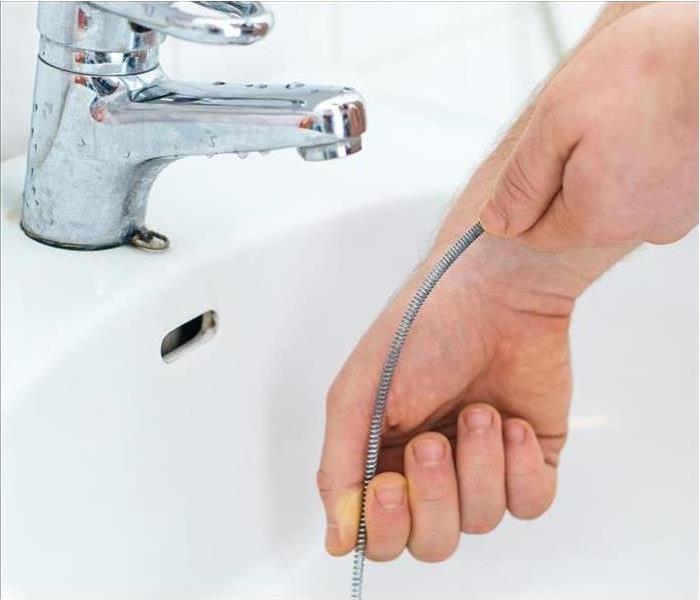 Use a plumbing snake to unclog the drain in your White Bear Lake, MN, home.
Use a plumbing snake to unclog the drain in your White Bear Lake, MN, home.
Whenever you have a clogged toilet or drain, plunging is usually the first thing you do to try to break up the clog. However, when plunging doesn't work, many people resort to chemical drain openers. Because these chemicals can damage your plumbing, it is better to first try clearing the clog with a plumbing snake.
How To Unclog a Drain or Toilet With a Plumbing Snake
Using a plumbing snake is not particularly complicated, but there are a few guidelines you should follow. If you don't already have a plumbing snake, you can purchase one from most hardware or home improvement stores.
- Insert the Snake Into the Drain or Toilet
If you are dealing with a stopped toilet, you can insert the snake, which looks like a long thin wire with a coil on the end, into the opening in the toilet bowl. For sink or tub drains, insert it directly into the drain. If the snake won't fit through the drain cover, you may have to remove the cover or purchase a smaller snake.
- Push the Snake Into the Drain Until You Feel Resistance
If you are using a manual snake, you will need to turn the handle to feed the snake into the drain. You may need to apply pressure to get past curved areas. If you are using an electric model, follow the operating instructions.
- Rotate the Snake Until the Resistance Goes Away
Once you have reached the clogged area, rotate the snake to break up the clog. Once the clog is broken up, the snake should slide easily into the rest of the drain. However, if you don't seem to be making any progress, try pulling the snake out of the drain. If the head has embedded or entangled the material in the clog, it may pull the clog out with it.
- Run the Water or Flush the Toilet
To make sure your drain is fully unclogged, run the water for a few minutes or flush the toilet a couple of times. If everything seems to be working properly, then you are probably done. If you still have a clogging problem, then repeat the process. If after trying again, you still have an issue, you may have a pipe break or other serious plumbing issue that needs professional attention. Call a plumber in White Bear Lake, MN, to assist you.
- Clean Up Any Water
Water from an overflowing toilet, sink, or tub can damage your home and lead to mold growth if not dried out quickly. You can remove small amounts of water with a wet/dry vacuum or a mop and bucket. However, large amounts of water or water that may contain contaminants may be better handled by a professional water remediation company. Try to completely dry out your home within 24 to 48 hours. After this amount of time, mold growth may become a problem.
There are many options for tackling a clogged toilet or drain. It is best to start with the methods that involve the least expense and potential for property damage, rather than jumping straight to calling a plumber or using potentially harmful chemicals.
4 Steps To Resolving Water In a Light Fixture
9/15/2022 (Permalink)
 Water in light fixtures is not uncommon.
Water in light fixtures is not uncommon.
While finding water in light fixtures may be a weird site, it is not uncommon, especially in multiple-story homes. However, it is not safe to leave water dripping into fixtures, so it is essential to resolve the problem quickly by contacting water mitigation professionals in White Bear Lake, MN.
Here Are 4 Steps To Resolve Water In a Light Fixture
- Shut off the breaker
- Call a specialist
- Resolve the issue
- Restore the property
1. Shut Off the Breaker
Before you concern yourself with ceiling damage, shut off the breaker to the affected light fixture. Water and electricity do not mix, and if left unattended can cause significant safety risks. Your breaker panel is likely found in your home's mechanical closet or basement.
2. Call a Specialist
After you shut off the breaker for the affected fixture, you can address the water in the light. However, you may want to call in a water mitigation company to assess the problem. Your house likely has a leak above the light fixture, and you will not know how bad the leak is until someone inspects the area thoroughly.
3. Resolve the Issue
When the mitigation crew arrives, they will inspect the area and offer an estimate for their services. Once you agree to the terms, the team will disassemble the light fixture and cut access holes into the ceiling. They will find the underlying leak and resolve the problem.
4. Restore the Property
After fixing the leak, the mitigation company will restore your property. They will patch any holes and replace all insulation and drywall affected by the leak. Finally, they will replace the light fixture and make sure that everything works as intended.
Almost no one expects to find water in light fixtures in their home, but it does happen. If you happen upon this type of damage, then turn off the electricity and contact a mitigation company for help. After all, there is no need to risk your safety.
Tips for Cleaning Items After a Flood
8/17/2022 (Permalink)
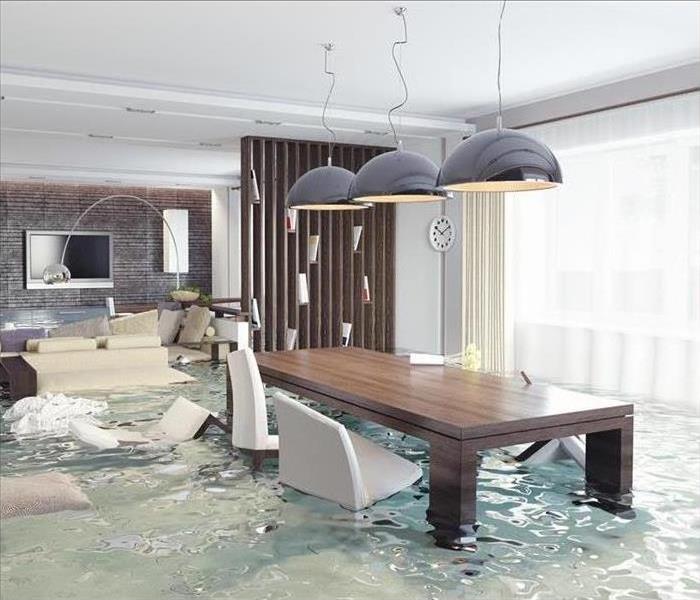 Hire professionals to deal with flood damage.
Hire professionals to deal with flood damage.
A heavy storm or busted pipe can leave a lot of water in your home in White Bear Lake, MN. Flooding not only affects the structure itself but also many of the items in the house. Before you throw everything away, it's worth trying to see what you can salvage.
3 Tips to Cleanup Items After a Flood
1. Dry Items
Files, photo albums and certificates that are drenched from a broken pipe may seem like a total loss. It may be possible to save them, though. The key to doing so is often to remove as much of the water as possible. You don't want to harm the items, so it's important to let them air dry. Avoid rushing the process with excess heat or light sources:
- Sunlight
- Oven
- Hair dryer
- Iron
You may be surprised how many items make it through the flood without secondary damage just fine as long as you allow them to dry gently.
2. Remove Dirt
Excess water in your home often brings extra grime along with it. Sturdy items can usually be rinsed with clean water to flush away some of the debris. If your furniture or curtains have dried, you may be able to brush away the residual dirt with a coarse-haired brush. Getting the worst of the dirt off can help make the mitigation process go more smoothly.
3. Hire Professionals
The most important thing you can do after a flood is rely on the expertise of flood remediation specialists. These technicians can help you determine which items to keep and which to discard. They also employ various methods such as dry cleaning and gamma radiation to restore your treasures.
Just because you have a lot of water in your home, that doesn't mean you have to lose everything. You can probably salvage even some of the more fragile family heirlooms with the right care and help. Consult your remediation experts before you throw anything away.
The Water Damage Timeline
7/19/2022 (Permalink)
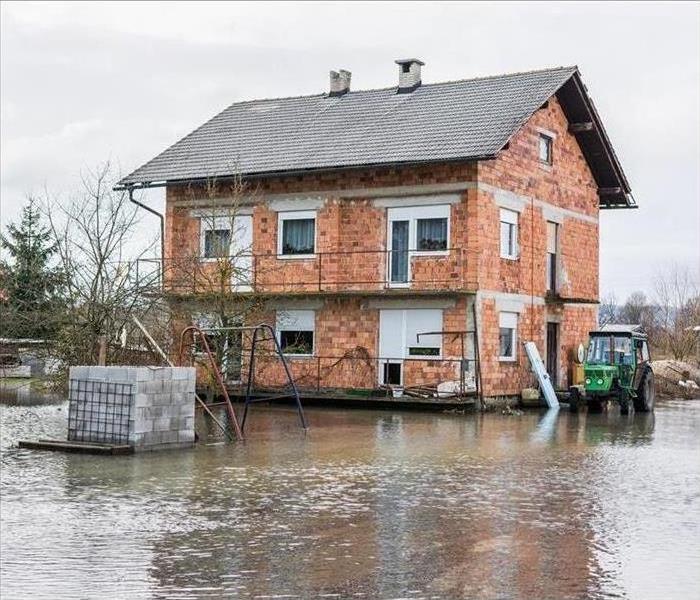 A fast response is very important to avoid further damage.
A fast response is very important to avoid further damage.
When your home is damaged by water, a 24 hour response is crucial. Water begins to cause serious problems within minutes. You might be wondering how this happens and what you can do about it.
You must begin water damage restoration as soon as you notice water damage. There are a few things that can cause this damage. These are:
- Storm flooding
- Burst pipes
- Sewage backups
- Main breaks
- Plumbing breaks
Calling a water damage restoration company White Bear Lake, MN, is crucial in preventing the damage from getting any worse. You want a company with a fast response because water damage only grows.
Water Damage Timeline
After the water begins to inundate an area, porous surfaces start to soak it up. Things like porous stone, paper and even cloth quickly become saturated. This causes these surfaces to start to break down almost immediately. The more porous the surface, the faster it starts to break down. This does not simply stop at the 24 hour mark but keeps going until the water is cleaned up.
Within a day, everything becomes water-laden and soggy. Anything sitting in or soaked in water will begin to decay. Depending on what kind of water you are dealing with, metals will begin to tarnish and wood swell. Dyes and other colors will fade. Mold growth is already beginning. If your restoration company isn't always open, it could allow the damage to get worse.
By the second day, mold has taken hold and continues to grow. At this point, many things are no longer salvageable. Textiles, furniture and clothing begin to deteriorate, and things like carpet and padding begin to rot. If you do not have a cleaning company working to rid your home of the water, this damage will continue to grow.
After two days, restoring it becomes even harder and more costly. It is always best to start restoration before the 24 hour mark to minimize the overall damage.
How To Prevent Contaminated Water Damage in Your Home While You're Away
6/17/2022 (Permalink)
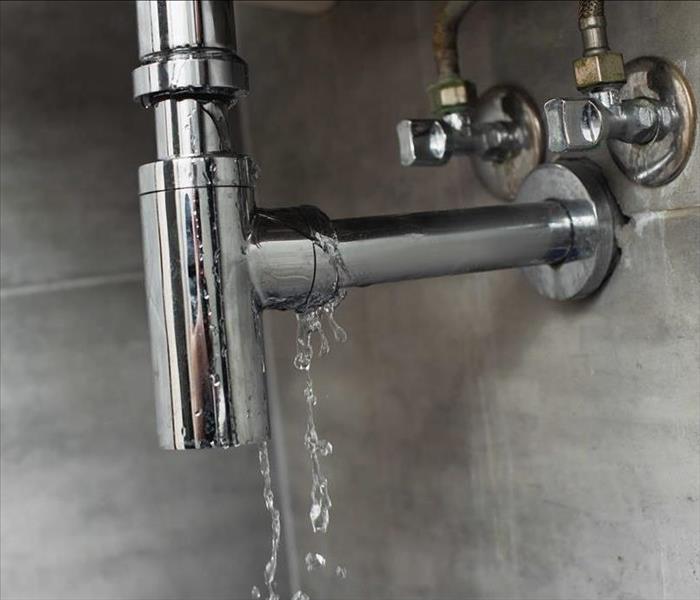 Follow our Tips and avoid Water Damage in Your Home.
Follow our Tips and avoid Water Damage in Your Home.
It's important to take time away from home to relax. Vacation allows you to spend time with your family away from the cares of your everyday life. Whether your family prefers a trip to the beach or a mountain getaway, the last thing you want is to come back to your home in White Bear Lake, MN, to a huge mess caused by contaminated water.
5 Strategies for Preventing Black Water Damage During Vacation
Before your trip, you probably focus on details such as making sure you have reservations at your destination and getting everything packed efficiently. Don't forget your home maintenance checklist, though. It can save you a lot of trouble in the long run.
1. Check for Leaks
Even clean water can cause extensive problems, especially if they go undetected for weeks. Before you leave for vacation, look for leaks in all the places they are typically found:
- Damaged supply line
- Loose or bent pipe
- Cracked toilet tank
- Leaky appliance hose
Call a local plumber to fix any problems with the hardware. Then contact a trusted water restoration company to assess and repair any water damage.
2. Insulate Pipes
If you are traveling during colder months, you may set your thermostat lower to save on energy costs. One possible drawback of this decision is that it makes your pipes more likely to freeze and break. You can still lower your heater, but make sure that you keep it running and that the warm air can reach all the pipes in your home. Additionally, insulate the pipes that are located along exterior walls.
3. Clean Gutters
Another way that contaminated water can enter your home when you're not there is from buildup along your roof and at the base of the house. This can happen when your gutters or downspouts are clogged with leaves, dirt and other debris. Make sure they are clear and that the spouts are positioned to direct runoff away from the foundation.
4. Test Sump Pump
Groundwater and sewer backup can easily flood your basement while you're away. A working sump pump is a solution for getting most of the black water out of your home so that it does as little damage as possible. Test it by filling up the basin and listening to the motor as it works.
It's also smart to have a backup energy source so that it can function even if the power goes out.
5. Turn Off Water Main
Ideally, you have people who can check on your home while you are on vacation. They can keep an eye out for anything that looks suspicious and call the right professionals to take care of it. If you don't know anyone who can help out, consider turning off your water main before you leave. That way, even if a pipe bursts, there's no water supply to cause a catastrophe.
Getting ready to go on a family trip involves more than just packing your suitcases and booking flights. You also need to make sure your home is not in danger of a flood from contaminated water or plumbing issues. Follow this checklist to ensure that your absence doesn't leave your home in potential peril.
How To Fix a Leaking Light Fixture
4/9/2022 (Permalink)
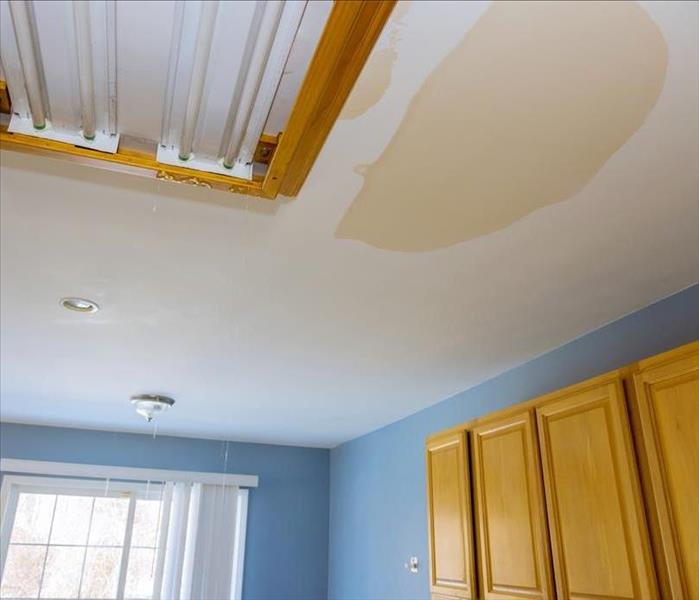 Learn More about How To Fix a Leaking Light Fixture by Following these Tips.
Learn More about How To Fix a Leaking Light Fixture by Following these Tips.
There are many ways a leak can start in your home. An overflowing toilet, damaged supply line or a malfunctioning appliance can all cause water to drain where you don't want it to go. A leak from an upper level of your home in North St. Paul, MN, not only causes water damage to the floor and walls in the room where it originates but also can leak into the walls, ceiling and light fixtures in the space below it.
If you see water in a light fixture, there are a few steps you need to take.
Practice Safety First
Electricity and water don't mix, so before you do anything else, you need to make sure that no water comes into contact with a live circuit. There are several immediate actions to take:
- Flip the circuit breaker that supplies power to the fixture off.
- Use a voltage tester on dry surfaces to confirm the electricity is off.
- Turn off the water main until you can find the source of the leak.
- Block off the area so that pets and children don't wander into it.
After you have these precautions in place, you can assess some of the water damage caused by the leak. This starts with finding the source.
Find the Cause of the Water Damage
The first place you should go, of course, is the room above the space with ceiling damage and a leaking light fixture. The reason the cause of the problem is important is that there are different cleanup methods used for different types of damage. For example, repairs prompted by an overflowing toilet must include thorough sanitation, and issues stemming from a pipe burst can turn out to be more widespread than you anticipate.
Contact Certified Technicians
The last step is to resolve the problem. Pinpointing where your leak came from not only informs which professionals you will need to call but also what they can expect when they arrive. You should never attempt to fix a leaking light fixture on your own. You need people who have the knowledge and the experience to complete the repairs correctly.
Contact certified professionals who can fix the leak and all the issues that it caused. If the source of the problem is a plumbing mishap, call a trusted plumber to repair the pipe, toilet or other feature before you turn the water back on.
To ensure that there is no residual electrical issue, hire an electrician to ensure that all the wiring to the light is intact and dry. Finally, you will need water damage repair specialists to tear out all the saturated materials, clean and dry the space, and rebuild the structure to ensure it is sound.
If you have moisture pooling in a light fixture in your home, you have a bigger problem than water damage to the structure to deal with. Take the appropriate safety precautions and call professionals who can assess and handle the situation quickly.
Your fast response may be the key factor in keeping an electrical or water problem from getting out of hand.
What Your Home's Plumbing System Has To Say About a Possible Pipe Break
11/15/2021 (Permalink)
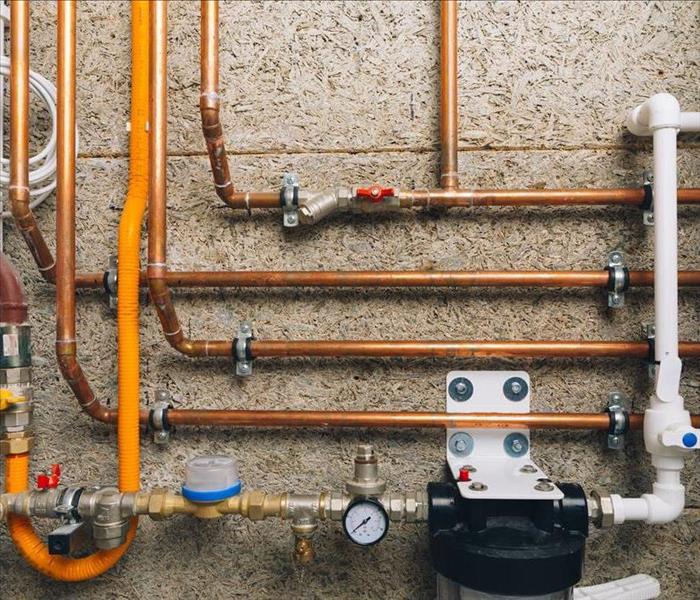 A pipe break in your North Saint Paul, MN, home can lead to water and mold damage.
A pipe break in your North Saint Paul, MN, home can lead to water and mold damage.
When the water pipes in your North Saint Paul, MN, home get noisy, they are actually letting you know about possible plumbing problems. You may hear hammering, bangs, and thumps, or squeals; any of these sounds could give you the chance to provide repairs before water damage from a pipe break happens.
Identify Your Home's Warnings of a Pipe Break
It's not uncommon for homeowners to feel a little spooked when they hear suspicious sounds from their water pipes. There's a good reason for this; plumbing mishaps, such as a pipe burst or drain backup, can leave you with a lot of messy, expensive cleanup. When you know what your pipes are trying to communicate, it's much easier to fix broken pipe before it leads to significant water damage.
Banging or Hammering
Any sounds similar to thumping and banging are likely caused by problems with water pressure or flow. For example, if a faucet is opened and then shut off suddenly, the pressure from rushing water causes a loud bang as the water hits the closed valve. This is known as a water hammer. Too much air pressure can also cause humming; this happens because too much pressure causes the pipes to vibrate.
Air bubbles are an example of a water flow problem. Pockets of air may become trapped in the pipes for a variety of reasons, and you may need help from a plumber to resolve this issue.
There are several forms of damage that could arise from water hammers, too much pressure, and an inconsistent flow of water:
- Weakened joints
- Damaged connections
- Waterlogged air chambers
- Potential pipe break
Remember, it's less expensive to pay for maintenance and small repairs than for large-scale repairs and professional water damage cleanup.
Gurgling or Sucking
If the pipes are becoming clogged or there's an obstruction somewhere along the line, you may hear a gurgling sound. The culprits could be a buildup of soap scum, hard water residue, or something that shouldn't have been flushed. Professional drain cleaners can usually remove the problem and, as a result, eliminate the gurgling, sucking sound.
Squealing
A high-pitched squeal, whine, or whistle often indicates worn components within the faucet, valves, or plumbing line. You should be able to determine the location of the worn part simply by listening. Homeowners can often handle faucet repairs, but washers and other components deep within the plumbing system may require expert attention. This is particularly important if the whine is situated near any gas lines.
Rattling and Clanking
Sometimes older pipes become detached from the walls, ceilings, or floors. There are many possible reasons for this:
- Rust has weakened fasteners.
- Very hot water caused copper pipes to expand, loosening fasteners.
- Structural elements of the home have decayed and no longer hold fasteners.
The plumbing system is usually hidden behind walls and between floors and ceilings. This makes it difficult for homeowners to address the problem and can make it very difficult to identify the exact location of the missing fastener.
You probably don't want to hear noisy pipes, but when your pipes do speak up, respond as quickly as possible to avoid the trouble and expense of a pipe break.
Bathrub Overflow Water Damage
8/17/2021 (Permalink)
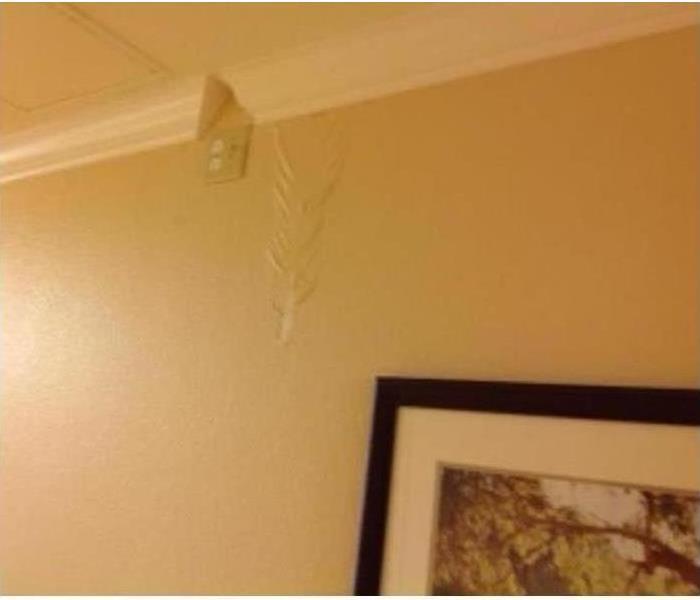 Water damage caused by an overflowing bathtub in Saint Paul, MN.
Water damage caused by an overflowing bathtub in Saint Paul, MN.
Water damage causes the most home insurance claims. Torrential rains, bursting pipes, and bathtub overflows are just a few potential causes of water damage. In fact, water damage is often caused by an overflowing bathtub. There are several reasons why this can happen, but no matter the cause, a professional water remediation company will need to step in to help you with the mitigation process.
No matter the cause of your bathtub overflow and water damage, you should know the six major reasons why this event can cause damage to your home in Saint Paul, MN.
Leaky Ceilings
If your bathtub is on the second floor, even if the overflow is quickly caught it could make small bubbles in your downstairs ceiling. Water could begin leaking, and you can have discoloration. If the amount of water is large, it could make your ceiling sag. Avoid entering the room if this happens, since more water or debris could fall and hurt you. Keep everyone out of the area until you have it fixed by an experienced technician.
Wet Drywall
An overflowing tub can easily damage drywall. It can weaken so badly when wet that you cannot fix it, and must be replaced. If there is a significant amount of water running down the walls, you should shut off the electricity. An electrician and plumber will need to check out the damage in this case along with SERVPRO professionals to ensure the leak is fixed and your home is safe and restored.
Ruined Flooring
Your floors can be ruined as well, especially wood or linoleum.
Damp Carpets And Furniture
Water coming through the ceiling can damage appliances and furniture. Mold can start to grow in your furniture and carpeting and can create a bad smell.
Bacteria Growth
Even if the water is clean, it can still cause bacteria to grow that could be harmful. This threat can develop when a significant amount of time passes before you get it cleaned up. The bacteria can grow with warm temperatures and time.
If your bathtub overflows, shut the source of the water off right away and give SERVPRO. We understand how damaging water can be and will be out to your property as quickly as possible to prevent more damage.
Plan Now To Avoid Frozen Pipes During Winter Temperatures
8/16/2021 (Permalink)
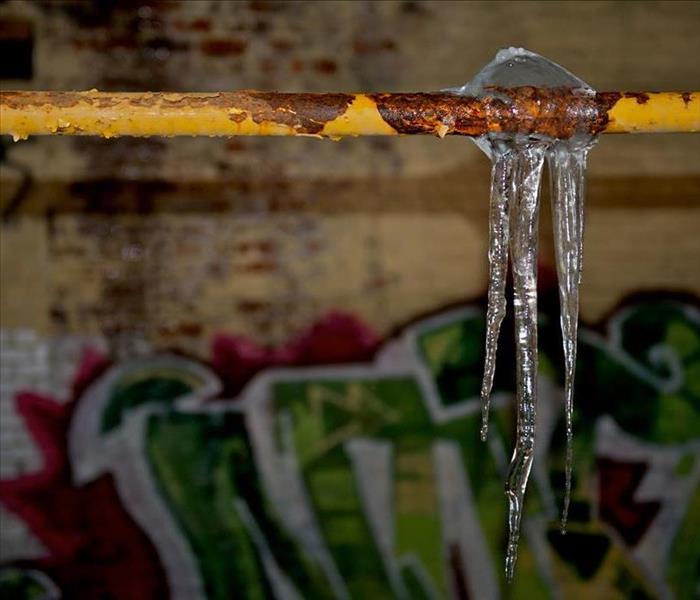 Cooler temperatures can freeze the pipes and break them in your commercial property in White Bear Lake, MN.
Cooler temperatures can freeze the pipes and break them in your commercial property in White Bear Lake, MN.
Once the summer temperatures fall and cooler weather settles in, there are many possible causes of water damage for business owners to consider. One of the most important situations to avoid is the damage that happens after freezing temperatures lead to broken pipes.
Prevent Frozen Pipes
Before jumping into the steps to take after the damage has happened, consider some steps you can take to protect your pipes and, hopefully, prevent them from breaking:
Identify areas of possible weakness, such as pipes that are exposed to the weather, pipes in unheated parts of the building, and unprotected pipes along exterior walls.
Drain water from hoses and pipes that won't be used during cold weather, such as the sprinkler system.
Remove exterior hoses and store them inside. Drain hoses and pipes before storing them for the winter.
Add insulation to exterior walls, basements, and other cold rooms in the building.
Consider products such as pipe sleeves and insulated covers. These protective covers could provide just enough warmth to keep water running when it's needed.
Remember that water expands when it freezes, so when the water in a pipe becomes cold enough to freeze, there's a lot of pressure from the inside of the pipe. The steps you can take to prevent broken pipes are effective ways to avoid a lot of water damage.
Keep Your Pipes Warm During the Winter
There are several other steps you can take to protect your commercial property in White Bear Lake, MN. These include setting your nighttime thermostat to a temperature above freezing, letting a small amount of cold water drip from the faucets during very cold weather, and opening cabinet doors to allow heated air to flow freely around the pipes. If your business is going to close for several days or longer, turn off the water to the building. Otherwise, you may return to serious flooding and the need for expensive water cleanup.
Respond to Frozen Pipes
Sometimes, in spite of your efforts, the pipes may still freeze. Even if there's no obvious damage, you may find that just a small trickle is all you're getting from the faucet. This is a clear sign that the pipes are frozen:
Leave the faucet open and begin looking for the section that's frozen.
Use a space heater, electric heating pad, or another gentle source of heat to treat the frozen section of the pipe. You could also warm up some towels to wrap around the pipes. As you slowly thaw the ice inside the pipes, you'll see a stronger flow of water from the faucet. Don't ever use any open flame, blowtorch, or propane heater to warm up the pipes.
Continue applying gentle heat until you have full water pressure from the faucet.
If you have one frozen pipe, there's a good chance that there are other clogged areas in the pipes. Test all of the faucets on your property.
If a burst pipe has caused serious water damage, contact local cleanup and reconstruction professionals. The sooner you respond to flooding and damage, the better you can avoid further expense and inconvenience.
My Home Has Flooded! Now What?
4/20/2021 (Permalink)
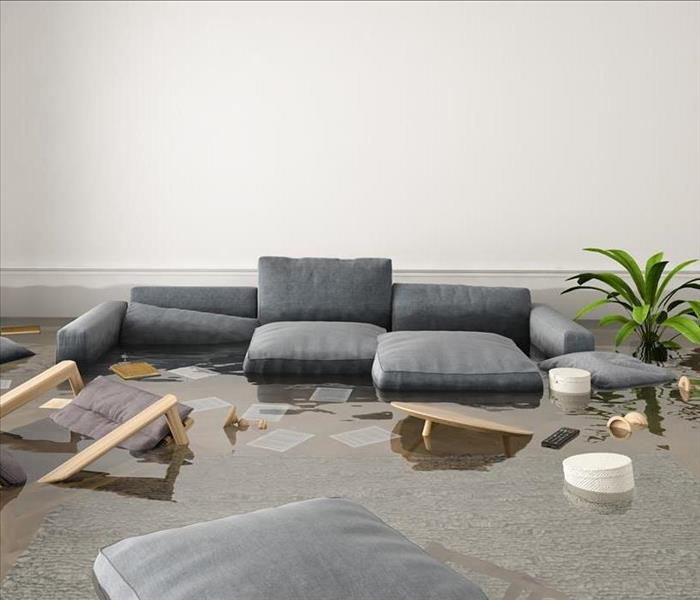 Flooding can cause severe damage and will need cleaning.
Flooding can cause severe damage and will need cleaning.
A flood is a flood whether it's a result of a burst pipe or a hurricane. Your White Bear Lake, MN, property will sustain the same basic types of water damage. Therefore, the remediation steps are essentially the same for every flood situation. The restoration process must begin immediately to avoid as much loss as possible.
Here are some tips for cleaning after your home sustains a flood:
5 Tips For Cleaning After Suffering Water Damage
1. Determine the Type of Water
Three varieties of water can enter your home. Clean water comes from uncontaminated water, such as rain or broken pipes. Gray water is slightly contaminated but generally not harmful (e.g., water from washing machines, dishwashers and clean toilets). Black water is severely contaminated water, such as that from a sewage overflow or a flood from a river or lake. It's critical to hire water cleanup specialists to properly clean and sanitize after a black water event.
2. Extract Standing Water
Extract all of the standing water immediately. Most materials will experience severe damage quickly. Additionally, porous materials are susceptible to mold growth within 24 hours of water exposure. A wet/dry vacuum is an excellent method of removing flood water.
3. Remove Everything
Remove as much as possible from the affected area. Then, the materials can be sorted into what's salvageable and what isn't. This process may even require some drywall removal. Carpet and padding will probably also be unsalvageable.
4. Dry Everything
The area must be dried thoroughly as quickly as possible to avoid further water damage and mold growth. Opening windows and doors and running dehumidifiers, fans and heaters can help dry the area quicker.
5. Clean and Disinfect Everything
All remaining materials that have been exposed to the water must be cleaned and disinfected. Remember to clean everything, including walls and crevices.
Water damage, whether from clean water or black water, can result in a severe loss. Begin the restoration process quickly to save your home from additional loss.
How To Deal With Water in a Light Fixture
11/26/2020 (Permalink)
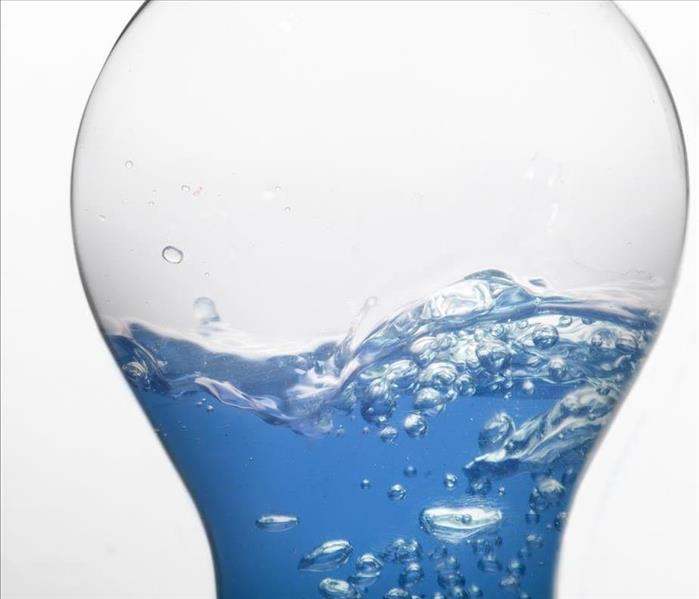 Water in light fixtures can be very dangerous.
Water in light fixtures can be very dangerous.
A flood from a busted pipe or supply line leak can affect more than just the surrounding area. This is particularly common when the faulty water source is on the second story of your home in White Bear Lake, MN. Not only can it cause water damage to the flooring and walls around it but also to the ceiling under it. Here are a few tips for getting the water out of the light fixture on your lower floor effectively and efficiently.
2 Tips To Deal With Water in a Light Fixture
1. Stay Safe
Your gut reaction may be to open up the fixture and just let the water drain out. This is not advisable until you have taken the necessary safety precautions:
- Shut off water to stop flooding.
- Flip breaker to cut power.
- Don rubber gloves and boots to neutralize residual charge.
Draining the fixture is one of the first steps toward taking care of the water damage to your lower floor. If you choose to touch the light before the restoration team arrives, make sure you are doing it safely.
2. Call Professionals
If the leak in your home has flooded two floors, you need water damage repair that goes beyond amateur abilities. When water has made its way into a light fixture on a lower level, you probably have quite a bit of ceiling damage on top of everything that needs mitigation on the higher floor. You need a team that has the experience and expertise to address the whole problem. As soon as you know there is an issue, call local water restoration specialists. They can assess the problem, propose solutions and provide an estimate of how much time and money it will probably take to fix it.
Water damage doesn't always stick to one area of your home. The more water involved, the farther and faster it can spread. It may even flood a lower floor, including the ceiling and light fixtures. Use the appropriate safety precautions and call for the help you need.
What to do About Your Noisy Water Heater
9/29/2020 (Permalink)
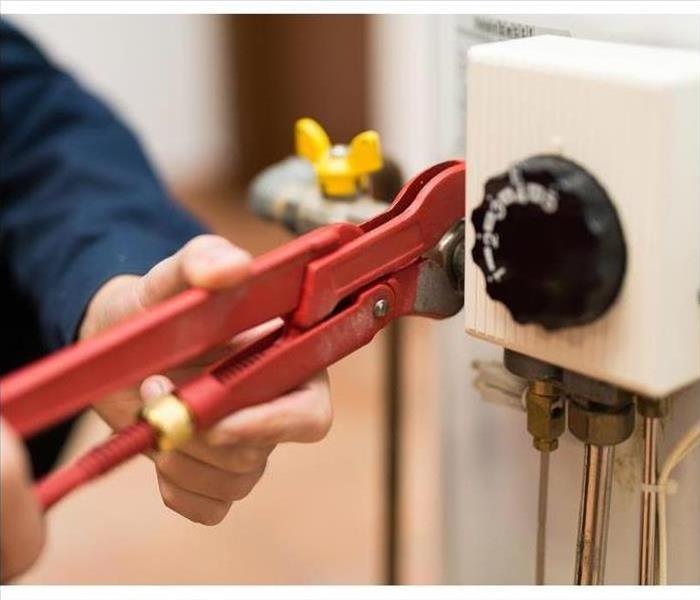 Water heater maintenance is one of the best ways to prevent leaks.
Water heater maintenance is one of the best ways to prevent leaks.
Your water heater is the lifeblood of your home. It controls the flow of water to your sinks, tubs, and major appliances while allowing you to regulate the desired temperature for drinking, bathing, and other needs for you and your family. Like any other major appliance, problems can occur over time, and repair and/or replacement costs can skyrocket when not properly maintained. Fortunately, simple observations may be enough to help you diagnose a potential problem as it arises.
Identifying Problems Through Listening
Water heater noises are varied and can stem from several potential problems. Some issues can be small and easy to fix yourself, while others may require professional help. Note the following common occurrences and their sounds:
Partially-closed valves – Water line valves that are partially closed forces water to push through smaller openings, creating a screaming sound. Ensure all valves are completely open when hearing this noise.
Sediment buildup – Sediment naturally forms over time around element tubes and traps water beneath the layers, indicated by a crackling sound. The element should be cleaned, or replaced if the noise persists.
Loose sediment – At times, sediment deposits can be stirred inside your tank when water is flowing through, causing a rumbling noise. Using a deliming solution during a water heater flush should solve the problem.
Additional Maintenance Notes
Water heater maintenance is one of the best ways to prevent leaks and premature breakdowns. The buildup of sediments and other minerals are a major cause for issues, particularly if you have hard water. Installing a water softener, and regular flushing and cleaning of the system can help prevent long term issues. If leaking does occur, always consult a water cleanup and mold remediation professional in White Bear Lake, MN, to ensure there is no extensive damage to your heater and the surrounding area. The cost of regular maintenance often pales in comparison to that of a major repair or replacement, so taking the time to observe your heater and keep it clean can save a fortune in the long run.
Involve Your Insurance Company for a Water Damage Claim
9/23/2020 (Permalink)
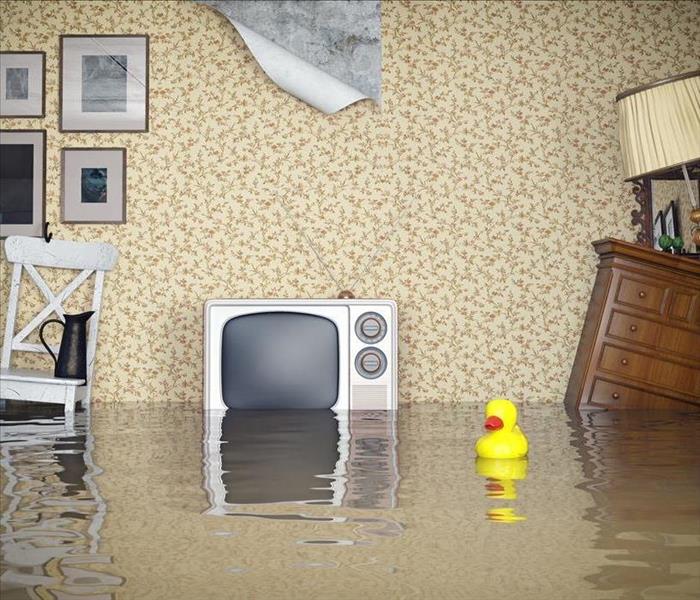 Water damage can be due to a bursting pipe or heavy rainfall.
Water damage can be due to a bursting pipe or heavy rainfall.
When your home has flooded because of a pipe burst situation or heavy rainfall, filing an insurance claim may not be one of the first things on your mind. However, the sooner you file your claim, the better the results for your home and your claim. Don't start cleaning up the water or moving your belongings around until after you have spoken to an agent. You may actually cause more damage or hurt the outcome of your case by jumping straight to cleanup and repairs.
3 Steps To Follow After Suffering Water Damage
1. Immediate Water Damage Response
Contact your agent as soon as possible because a quick response to water damage is vital. You'll need the following information to share with the insurance company:
- A copy of your insurance policy
- Details of the water damage (avoid using the word "flood")
- An inventory of your damaged property
- Contact information for anyone involved
- Questions about how to proceed
In some cases, your insurance agent may have recommendations about who to contact for water damage cleanup and repair.
2. Your Next Steps
After contacting the necessary professionals to start the insurance claim process, there are several more steps you can take. These involve taking pictures of the damage and creating a safe place to store receipts and documents relating to the damage. You may also want to contact an adjuster for a second opinion regarding the costs of damage, losses, and repair.
3. Mitigation Steps
During your conversation with insurance professionals, you may be advised to start removing water, boarding up holes, and other preventative steps. If you fail to complete these tasks, further damage may occur, and the new damage may not be covered by your insurance. Remember to save receipts and make notes about any new information you discover.
Most of the time, you'll have better success with your insurance claim if you involve restoration experts in the cleanup and repair of your home in White Bear Lake, MN. These experienced professionals may also help you work with the insurance company for better results. Keep communication lines between all parties open and respectful for the very best results.
What is a Category 3 Water Damage?
9/4/2020 (Permalink)
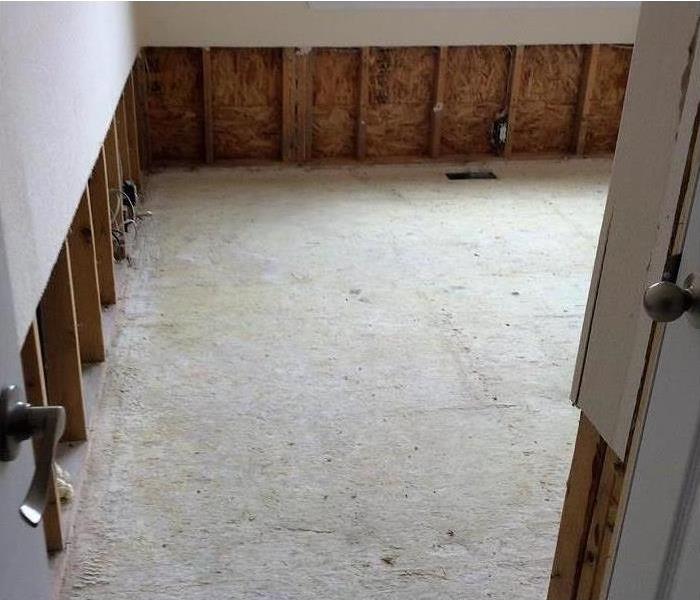 Sewage Damage needed to be removed from this home. The drywall, carpet, and pad will all be replaced.
Sewage Damage needed to be removed from this home. The drywall, carpet, and pad will all be replaced.
What is a biohazard? The term biohazard refers to any biological materials (microorganisms, plants, animals, or their byproducts) that pose a threat to the health of living organisms.
By IICRC water categories, sewage is considered a category 3 "Black Water"
Category 3 water is grossly contaminated and could cause severe illness or death if ingested and any contact should be avoided. Examples include flooding from rivers or streams, water from beyond the toilet trap, water from the toilet bowl with feces, or standing water that has begun to support microbial growth.
- May contain untreated sewage, harsh chemicals, and microbes
- Water from flooding rivers or sewer backup
Sewer backups should be considered an emergency since the water may contain viruses, bacteria, and other microbes that cause serious illnesses. SERVPRO Professionals have specialized training and equipment to quickly and safely clean contaminants like sewage.
Don't wait for the damage to get worse. Call us today to have your home cleaned from Category 3 Water Damage.
Preventing a Worse Water Damage
9/4/2020 (Permalink)
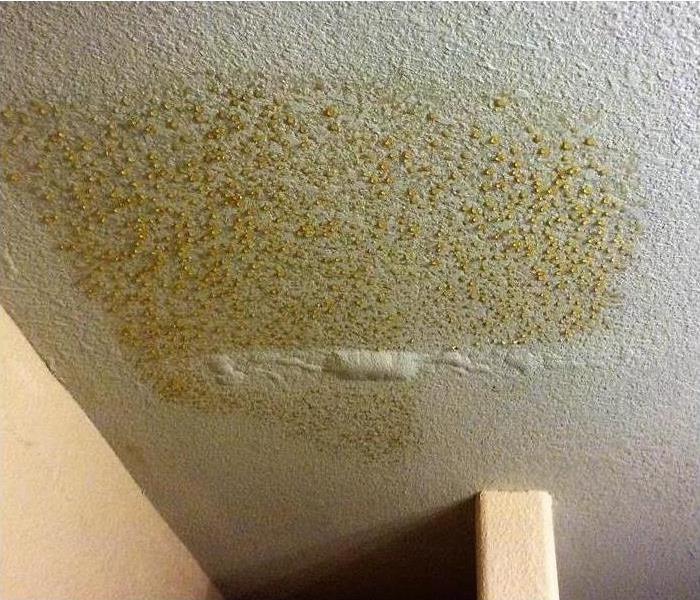 Water from above caused the ceiling damage to this White Bear Lake home.
Water from above caused the ceiling damage to this White Bear Lake home.
Removing surface water can help prevent more extensive damage. However, water intrusions invade floors, ceilings and walls to find the lowest point in your home. Standing water from an overflowing bathtub or other water incident will search for pin hole crevices and cracks in your floors and walls looking for a way to travel downward. Surfaces such as wood, drywall and carpet pull water away from plain sight and into the interiors of your home. Below is what you can do as you wait for the professionals from SERVPRO to arrive:
- Shut off the water source if possible or
contact a qualified party to stop the
water source. - Turn off circuit breakers for wet areas of the
building, if access to power distribution
panel is safe from electrical shock.� - Remove as much excess water as possible by mopping or blotting.
- Wipe excess water from wood furniture
after removing lamps and tabletop items. - Remove and prop up wet upholstery
cushions for even drying. - Place aluminum foil or wood blocks
between furniture and wet carpeting. - Remove to a safe, dry place any paintings,
art objects, computers, documents and
other materials that are valuable or sensitive
to moisture. - Do not enter affected areas if electrical
outlets, switches, circuit breakers or electrical equipment are exposed to water. Always avoid electrical hazards. - Don’t use a household vacuum to remove
water. This could cause electrical shock or
damage to the vacuum.
 Hire a professional team to clean after a flood to avoid water damage in your White Bear Lake, MN property.
Hire a professional team to clean after a flood to avoid water damage in your White Bear Lake, MN property.

 24/7 Emergency Service
24/7 Emergency Service














